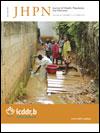Risk Factors Associated with Severe Underweight among Young Children Reporting to a Diarrhoea Treatment Facility in Bangladesh
DOI:
https://doi.org/10.3329/jhpn.v28i5.6156Keywords:
Body-weight, Case-control studies, Child, Child nutritional status, Infant, Infant nutritional status, Risk factors, Thinness, BangladeshAbstract
Protein-energy malnutrition (PEM) is a serious health problem among young children in Bangladesh. PEM increases childhood morbidity and mortality. Information is needed on the major risk factors for PEM to assist with the design and targeting of appropriate prevention programmes. To compare the underlying characteristics of children, aged 6-24 months, with or without severe underweight, reporting to the Dhaka Hospital of ICDDR,B in Bangladesh, a case-control study was conducted among 507 children with weight for- age z-score (WAZ) <-3 and 500 comparison children from the same communities with WAZ >-2.5. There were no significant differences between the groups in age [overall mean±standard deviation (SD) 12.6±4.1 months] or sex ratio (44% girls), area of residence, or year of enrollment. Results of logistic regression analysis revealed that severely-underweight children were more likely to have: undernourished mothers [body mass index (BMI) <18.5, adjusted odds ratio (AOR)=3.8, 95% confidence interval (CI) 2.6-5.4] who were aged <19 years (AOR=3.0, 95% CI 1.9-4.8) and completed <5 years of education (AOR=2.7, 95% CI 1.9-3.8), had a history of shorter duration of predominant breastfeeding (<4 months, AOR=2.3, 95% CI 1.6-3.3), discontinued breastfeeding (AOR=2.0, 95% CI 1.1-3.5), and had higher birth-order (>3 AOR=1.8, 95% CI 1.2- 2.7); and fathers who were rickshaw-pullers or unskilled day-labourers (AOR=4.4; 95% CI 3.1-6.1) and completed <5 years of education (AOR=1.5; 95% CI 1.1-2.2), came from poorer families (monthly income of Tk <5,000, AOR=2.7, 95% CI 1.9-3.8). Parental education, economic and nutritional characteristics, child-feeding practices, and birth-order were important risk factors for severe underweight in this population, and these characteristics can be used for designing and targeting preventive intervention programmes.
Key words: Body-weight; Case-control studies; Child; Child nutritional status; Infant; Infant nutritional status; Risk factors; Thinness; Bangladesh
DOI: 10.3329/jhpn.v28i5.6156
J HEALTH POPUL NUTR 2010 Oct;28(5):476-483
Downloads
288
267

